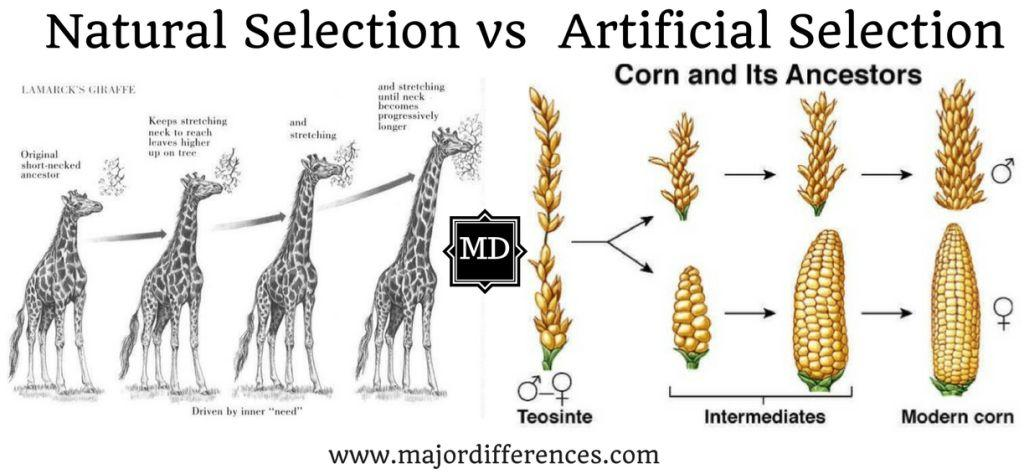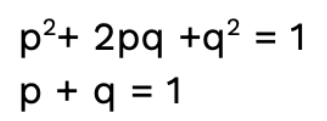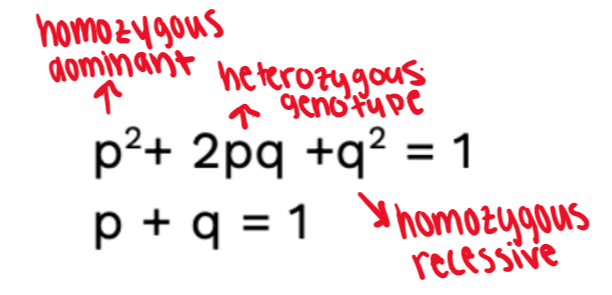Unit 7
Introduction to Natural Selection 7.1
Natural selection is a major mechanism of evolution.
States that there are 3 propositions of natural selection…
- %%Species change over time%%
- %%Divergent species share a common ancestor%%
- %%Natural Selection is the mechanism that produces these changes in species/populations%%
He noticed that individuals with more %%favorable phenotypes%% are more likely to %%survive%% and produce more offspring therefore %%passing traits to subsequent generations%% (survival of the fittest)
Evolutionary fitness- @@the phenotypes that are directly related to the survival of a species or population@@
Fitness- @@reproductive capability of animals@@
Relative fitness- The contribution an individual makes to the gene pool of the next generation @@relative@@ @@to the contributions of other individuals@@
Animals with %%disadvantageous phenotypes%% usually %%die off%% because they are easily spotted by predators making the bad phenotypes %%not have a chance to reproduce%%.
Basically changes phenotypic ratios to make the population stronger
Biotic and abiotic factors play into natural selection
A population will be affected by abiotic and biotic factors in any biome
EX. Biotic- vegetation, predators, and prey
EX. Abiotic- soil, temperature, other non-living environmental components
Natural Selection 7.2
Natural selection acts on phenotypic variations
Phenotype- @@An observable trait of any individual@@
Phenotype EX. human hair
Each population will have a variety of individual phenotypes
Directional selection- @@Occurs when condition favor individuals exhibiting one extreme of a phenotypic range, environments change and apply selective pressures to populations@@
The peppered moths wings used to be white to blend in but then their wings got darker and soon the environment got darker. The dark moth had better odds than the white one.
If the enviornment didn’t change, the darker moths would most likely be killed off and lowered their fitness.
Disruptive selection- @@Occurs when conditions favor individuals at both extremes of a phenotypic range over individuals with intermediate phenotypes, lower relative fitness@@
Stabilizing selection- @@Removes extreme variants from the population and preserves intermediate types, reduces variation and tends t maintain the status quo for a particular phenotypic character@@
This shows that some phenotypic variations significantly increase or decrease fitness depending on the environment
Artificial Selection 7.3
Through artificial selection, humans affect variation in other species
We do this to keep desirable traits and get rid of potentially harmful characteristics.
EX. breeding dogs, growing corn and wheat
Artificial selection- how humans can manipulate te phenotypic variety of a population
Convergent evolution is when manipulations occur due to the environment pressures (not artificial).
It occurs when similar selective pressures result in similar phenotypic adaptions in different populations or species
EX. Wings; many species have wings but they do not all share a common ancestor. Even their wing structure develops independently

Population Genetics 7.4
Evolution is driven by random occurrences like…
Mutations
Genetic Drifts
Migration/Gene Flow
Mutations
The leading factor in genetic variety
Some can affect species fitness while others are neutral
Some can also be beneficial like peppered moth’s while some can be harmful
Genetic drift
Genetic drift- any random event, like a natural disaster, that greatly affects the environment
If this occurrence kills all organisms with a specific allele, then that phenotype can no longer exist in that population
Founders Effect
A type of genetic drift that occurs when a small group breaks away from their population and colonizes a new area
This can lead to a new allele being overrepresented in the new group an possibly become the dominant trait
Bottlenecks
A type of genetic drift when the resulting population is a lot smaller and not representative of all the alleles and frequencies of the original population
Basically when the allele frequency of the original group is also changed
Gene flow
Gene flow- How immigration and emigration can affect allele frequencies as well
It is more common with less disasters and helps to explain how alleles and phenotypes can be added and removed from populations
The mechanisms like genetic drift and gene flow can reduce genetic variation in population, but can also separate them as well
In the founders effect, 2 populations may begin to reproduce and evolve separately each with their own favorable traits
If the 2 groups of species don’t reproduce with each other then it can lead to speciation
Speciation- The development of 2 entirely different species
Once this occurs it would be almost impossible for the 2 species to reproduce because they have vastly different allele frequencies and genetic variety
Mutation can also do this
Mutation results in genetic variation, which provided phenotypes on which natural selection acts happen
If one bloodline of a species has a mutation, this can alter their alleles and phenotypes to the point of no reproduction with other species in the same population,
Hardy-Weinberg Equilibrium 7.5
A model in which if these 5 condition exist, allele frequencies will not change
- %%No mutation%%
- %%No type of selection acting upon the population%% (artificial, sexual, natural)
- %%No gene flow%% (immigration and emigration)
- %%Population size is infinite%% (cant be affected by natural disasters and genetic drift)
- %%Mating is random%%
These scenarios are impossible in the natural world that is why it acts as a model to calculate genotypic ratios under these false assumptions
While using this model, we can calculate ratios that can serve as a null hypothesis for evolution
PUNNETT SQUARE
| ==C^G== | ^^C^R^^ | |
|---|---|---|
| ==C^G== | ==C^G C^G== | ==C^G== ^^C^R^^ |
| ^^C^R^^ | ==C^G== ^^C^R^^ | ^^C^R C^R^^ |
The Punnett square factored out is the formula below
Equation for allele frequencies in a population (Hardy-Weinberg Equation)
 p=frequency of allele 1 in the population (dominate)
p=frequency of allele 1 in the population (dominate)
q=frequency of allele 2 in population (recessive)
 ==(C^G)(C^G)=p^2== ==(C^R)(C^R)=q^2== (often given to you) ==(C^G)(C^R)=2pq==
==(C^G)(C^G)=p^2== ==(C^R)(C^R)=q^2== (often given to you) ==(C^G)(C^R)=2pq==
Changes in allele frequencies provide evidence for the occurrence of evolution in a population
Small populations are more susceptible to random environmental impact that large populations
Evidence of Evolution 7.6
Evolution is supported by scientific evidence from many disciplines…
Geographical data
Physical data
Biochemical data- amino acid sequence of proteins
Mathematical data
Molecular, morphological, and genetic evidence from extant and extinct organisms adds to our understanding of evolution.
Fossils can be dated by a variety of methods…
Age of rocks surrounding where a fossil is found
- By looking around the area, they can get a good sense of what era the fossil is from by using geographical data
- The rate of decay of isotopes including carbon
- Geographical data
Morphological homologies represent features shared by a common ancestor
This includes vestigial structures which are anatomical features or behaviors that no longer seem to have a purpose in the current form of an organism of a given species but were used by its ancestors
EX- Wisdom teeth, human body hair, our tailbone, wings on flightless birds
Another similar phenomenon in evolution are homologous structures.
These are structures or organs that may have similar functions or structures and suggest a connection to a common ancestor.
EX- Humans, dogs, birds, and whales all have the same bones, but not arranged and connected in the same way. They have similarities which serve an overall similar purpose
On the molecular level, DNA nucleotide sequences and/or amino acid sequences have been compared for similarity. They can be used to determine if 2 species shared a common ancestor and any other possible species
All organisms have the same DNA, similar genetic codes, same amino acids, and similar processes for DNA replication. It not just a coincidence and it supports the theory of evolution